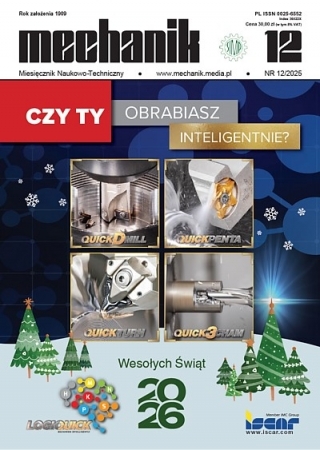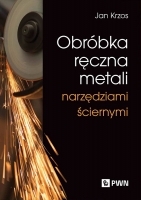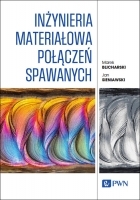Studium obrabialności stali nierdzewnej X2Cr18Ni8 poddanej wierceniu
Elementary Study of the Machinability During Drilling of Stainless Steels X2Cr18Ni8
Mechanik nr 04/2015 - Artykuły z XII Międzynarodowej Konferencji Electromachining 2015 zamieszczone na płycie CD
STRESZCZENIE: Przed wdrożeniem nowych tworzyw konstrukcyjnych do procesu obróbki skrawaniem niezbędne są precyzyjne i niezawodne informacje o ich obrabialności, przy czym powinny być one sprawdzone aktualnymi metodami. W artykule przedstawiono wnioski z badania obrabialności austenitycznej stali nierdzewnej X2Cr18Ni8, opisano także właściwe parametry strefy skrawania w procesie wiercenia. W artykule skupiono się na analizie czterech podstawowych parametrów obrabialności stali w wybranych zakresach.
SŁOWA KLUCZOWE: wiercenie, strefa skrawania, odkształcenie plastyczne, stal nierdzewna, obrabialność.
ABSTRACT: Precise and reliable information on the machinability of a material before it enters the machining process is a necessity, and hypotheses must be tested through verification of actual methods. This article presents conclusions of machinability tests on austenitic stainless steels X2Cr18ni8 and describes appropriate parameters for the cutting zone during the process of drilling. The article focuses on the analysis of selected domains through four basic some parameters of steel machinability.
KEYWORDS: drilling, cutting zone, plastic deformation, stainless steels, machinability, machined surface.
BIBLIOGRAFIA / BIBLIOGRAPHY:
- Abrao A.M.. Aspinwall D.K.: The surface integrity of turned and ground hardened bearing steel, Wear, vol. 196, 279–284, 1996.
- Agapiou J.S., Halldin G.W., DeVries M.F.: On the Machinability of Powder Metallurgy Austenitic Stainless Steels. Journal of Engineering for Industry. Transaction of the ASME, vol.110, No.11, 339-343, 1988.
- Arsecularatne J.-Fowle R.,-Mathew P.: Prediction of Chip Flow Direction, Cutting Forces and Surface Roughness in Finish Turning. Journal of Manufacturing Science and Engineering, vol. 120, No.2, 1-12, 1998.
- Belluco L. De Chiffre L.: Evaluation of vegetable-based oils in drilling austenitic stainless steels. Journal of Materials Processing Technology 148,171-176, 2004.
- Ceretti E., Giardini,C.A., Filice A. Rizzuti L., Umbrello,S.D.: Diffusion wear modelling in 3D cutting process. International Journal of Machining and Machinability of Materials, vol.6, No.1/2, 95-105, 2009.
- Chandrasekaran H., Johansson,J.: (1994). Chip Flow and Notch Wear Mechanisms during the Machining of High Austenitic Stainless Steels. Annals of the CIRP, vol. 43, 1, 101-105, 1994.
- Clift S.E, .Hartley P., Sturgess C.E.N., Rowe G.W.: Fracture prediction in plastic deformation processes. International Journal of Mechanical Sciences, vol.32, No. 1, 1-17, 1990.
- Cook N.: What is Machinability? Proceedings of an International Symposium on Influence of Metallurgy on Machinability. ASM 1975,, 1-10, 1975.
- DeVries W.R.: Analysis of material removal processes. New York, Springer-Verlag, 1991.
- Dolinšek S.: Work-hardening in the drilling of austenitic stainless steels. Journal of Materials Processing Technology, vol. 133, No.1/2, 63-70, 2003.
- Fang X.D.: Experimental investigation of overall machining performance with overall progressive tool wear at different tool faces. Wear, vol. 173, 171–178, 1994.
- Fujiwara T. Kato T., Abeyama S., Nakamura,S.: Effects of Free-Machining Additives on Machinability of the 18Cr-2Mo Stainless Steel. Proceedings of the International Symposium on Influence of Metallurgy on Machinability of Steel,. Tokyo, 231-240, 1977.
- Grzesik W.: Influence of tool wear on surface roughness in hard turning using differently shaped ceramic tools. Wear, vol.265, No.3-4, 327-335, 2008.
- Jurko J., Panda A., Gajdoš M.: Accompanying phenomena in the cutting zone machinability during turning of stainless steels. International Journal Machining and Machinability of Materials, vol.5, No.4, 383-400, 2009.
- Jurko J.: Monitoring and Diagnosis of Drill Wear and the Thermodynamic Phenomenas of Material Removal by drilling of Stainless Steels. Book: Experimental Analysis of Nano- and Engineering Materials and Structures, 77-78, 2007.
- Shaw M.C.: Metal cutting principles, 2nd edition, NY: Oxford University Press, 2005.
- Stephenson D.A., Agapiou J.S.: Metal Cutting Theory and Practice. Second Edition, 2005.
- Uehara K.: On the mechanism of crater wear of carbide cutting tools. Annals of the CIRP, vol. 21, No. 1, 31–32, 1972.
- Usui E., Hirota A.: Analytical Prediction of Three Dimensional Cutting Process. Part 2-Chip formation and Cutting Forces with Conventional Single-Point Tool. Journal of Engineering for Industry. Transaction of the ASME, vol. 100, No. 2, .236-243, 1978.
- Venkatesh V.C.: Tool wear investigations on some cutting tool materials, Journal of Lubrication Technology, vol. 102, 556–559, 1980.
- ZumGahr H.: Microstructure and Wear of Materials. Elsevier, Amsterdam, 1987.
- Yeo S.H.: A Tandem Approach to Selection of Machinability Data. International Journal Advanced Manufacturing Technology, vol. 10, No. 2, 79-86, 1995.
- DIN 50320: Verschleiss-Begriffe, Analyse von Verschleissvorgängen, Gliederung des Verschliessgebietes. Beuth Verlag, Berlín,1979.





















